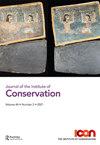对伊朗萨法维时期两批波斯铜币的腐蚀机制和保存状况的技术研究
IF 1
0 HUMANITIES, MULTIDISCIPLINARY
引用次数: 3
摘要
在伊朗西部的哈马丹发现了一系列锈蚀的萨法维铜币,这些铜币可以追溯到公元17世纪,在伊斯法罕铸造。对这些硬币的选择进行了研究,以确定铸造过程,腐蚀形态和机制,以及它们的保存状态。利用金相、ICP-OES、SEM-EDS和XRD分析了两堆硬币中的8枚硬币,以确定它们的金属/合金成分和微观结构,以及任何腐蚀层和产物的化学成分。结果表明,这些硬币是用热机械加工的毛坯铸造而成的,产生了浮雕状的表面。发现腐蚀形态包括两层腐蚀外壳,其中原始表面保留完好,并且确定的腐蚀机制是铜的内部溶解和氧化以及铜(II)化合物在原始表面上的形成。腐蚀产物中氯化合物的存在表明,这些硬币已经患上了“青铜病”,因此任何预防性保护都必须包括将其储存和展览环境的相对湿度保持在45%以下。本文章由计算机程序翻译,如有差异,请以英文原文为准。
Technical studies on the mechanisms of corrosion and state of conservation of two hoards of Persian copper coins (folus) from the Safavid period in Iran
Abstract A series of corroded Safavid copper coins (folus) dating to the seventeenth century CE and minted in Isfahan were discovered in Hamedan, Western Iran. A selection of these coins was studied to identify the minting process, corrosion morphology and mechanisms, and their state of conservation. Eight coins from two hoards were analysed using metallography, ICP–OES, SEM–EDS and XRD to identify their metal/alloy compositions and microstructures, as well as the chemical compositions of any corrosion layers and products. The results showed that the coins were minted from blanks using thermo-mechanical processing to produce their relief-like surfaces. The corrosion morphology was found to include a two-layered corrosion crust in which the original surface was well-retained, and the corrosion mechanisms identified were internal dissolution and oxidation of copper and the formation of copper (II) compounds over the original surface. The presence of chloride compounds in the corrosion products showed that the coins have been suffering from ‘bronze disease’ so that any preventive conservation must include keeping the relative humidity of their storage and exhibition environments below 45%.
求助全文
通过发布文献求助,成功后即可免费获取论文全文。
去求助
来源期刊

Journal of the Institute of Conservation
HUMANITIES, MULTIDISCIPLINARY-
CiteScore
1.50
自引率
0.00%
发文量
22
期刊介绍:
The Journal of the Institute of Conservation is the peer reviewed publication of the Institute of Conservation (Icon). As such, its aims reflect those of Icon, to advance knowledge and education in conservation and achieve the long term preservation and conservation of moveable and immoveable cultural heritage. The Journal provides a collective identity for conservators; it promotes and supports both the profession and professionalism. With international contributions on all aspects of conservation, it is an invaluable resource for the heritage sector. The specific aims of the Journal are to: 1. promote research, knowledge and understanding of cultural heritage conservation through its history, practice and theory 2. provide an international forum to enable and disseminate advances in research, knowledge and understanding relating to conservation and heritage 3. champion and support professional standards of heritage conservation in the UK and internationally 4. provide a permanent record of issues relating to conservation and heritage 5. be financially and operationally sustainable. To achieve these aims, the Journal invites contributions from all those involved in the conservation of cultural heritage and related activities. Areas of interest include understanding cultural heritage materials and their degradation; subject reviews and histories of cultural heritage materials and conservation treatments; new, innovative or improved approaches to conservation and collections care theory, practice, communication, management and training; case studies demonstrating new, innovative or improved approaches; and conservation in its wider context. Submitters are encouraged to demonstrate how their work is of practical application to conservation. To maintain professional standards and promote academic rigour, submissions of articles and shorter notices are subject to an anonymous peer review process.
 求助内容:
求助内容: 应助结果提醒方式:
应助结果提醒方式:


